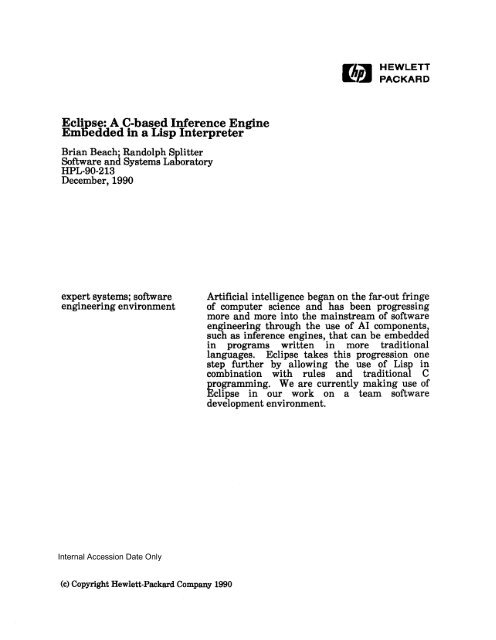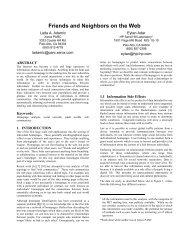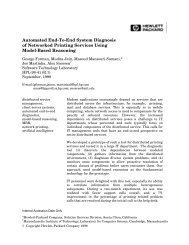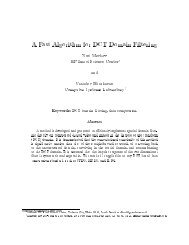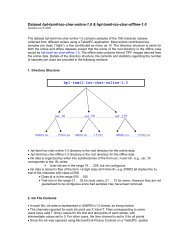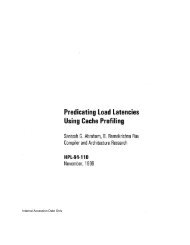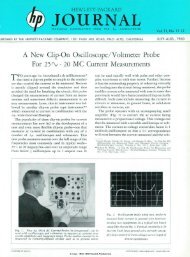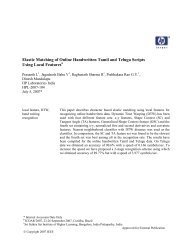Eclipse: A C-based Inference Engine Embedded in a Lisp Interpreter
Eclipse: A C-based Inference Engine Embedded in a Lisp Interpreter
Eclipse: A C-based Inference Engine Embedded in a Lisp Interpreter
You also want an ePaper? Increase the reach of your titles
YUMPU automatically turns print PDFs into web optimized ePapers that Google loves.
HEWLETT<br />
PACKARD<br />
<strong>Eclipse</strong>: A C-<strong>based</strong> <strong>Inference</strong> <strong>Eng<strong>in</strong>e</strong><br />
Em6edded <strong>in</strong> a <strong>Lisp</strong> <strong>Interpreter</strong><br />
Brian Beach; Randolph Splitter<br />
Software and Systems Laboratory<br />
HPL-90-213<br />
December, 1990<br />
expert systems; software<br />
eng<strong>in</strong>eer<strong>in</strong>g environment<br />
Artificial <strong>in</strong>telligence began on the far-out fr<strong>in</strong>ge<br />
of computer science and has been progress<strong>in</strong>g<br />
more and more <strong>in</strong>to the ma<strong>in</strong>stream of software<br />
eng<strong>in</strong>eer<strong>in</strong>g through the use of AI components,<br />
such as <strong>in</strong>ference eng<strong>in</strong>es, that can be embedded<br />
<strong>in</strong> programs written <strong>in</strong> more traditional<br />
languages. <strong>Eclipse</strong> takes this progression one<br />
step further by allow<strong>in</strong>g the use of <strong>Lisp</strong> <strong>in</strong><br />
comb<strong>in</strong>ation with rules and traditional C<br />
programm<strong>in</strong>g. Weare currently mak<strong>in</strong>g use of<br />
<strong>Eclipse</strong> <strong>in</strong> our work on a team software<br />
development environment.<br />
Internal Accession Date Only<br />
(c)Copyright Hewlett-Packard Company 1990
1 Introduction<br />
<strong>Eclipse</strong>, the subject of this paper, is one component of an object-<strong>based</strong> software development<br />
environment (SDE), that is be<strong>in</strong>g developed at Hewlett-Packard Labs <strong>in</strong> Palo Alto.<br />
This SDE is designed to support teams of developers build<strong>in</strong>g large software systems. In<br />
addition to provid<strong>in</strong>g a shared object base of project-wide <strong>in</strong>formation, the environment<br />
provides rule-<strong>based</strong> support for manag<strong>in</strong>g the software development process. These rules<br />
create an active database that responds to user actions, checks constra<strong>in</strong>ts and automates<br />
repetitive tasks. A typical constra<strong>in</strong>t rule might require that a software module pass certa<strong>in</strong><br />
tests before be<strong>in</strong>g <strong>in</strong>cluded <strong>in</strong> a release.<br />
For reasons of efficiency, the rules are attached not to the persistent, project-wide object<br />
base but rather to a local cache of objects <strong>in</strong> the virtual memory of each developer's workstation.<br />
This active cache of objects is stored <strong>in</strong> <strong>Eclipse</strong>, which is a fusion of XLISP [Bet89]<br />
and CLIPS [CLI88]. XLISP is a small, fast and powerful <strong>Lisp</strong> <strong>in</strong>terpreter written <strong>in</strong> C, with<br />
easy l<strong>in</strong>kage to external rout<strong>in</strong>es written <strong>in</strong> C. CLIPS (C Language Production System)<br />
is a forward-cha<strong>in</strong><strong>in</strong>g <strong>in</strong>ference system developed at NASA's Johnson Space Center. We<br />
have <strong>in</strong>tegrated XLISP and CLIPS and added some additional features as well.<br />
<strong>Eclipse</strong> has been developed as a component of the SDE, but we th<strong>in</strong>k that it could be<br />
useful <strong>in</strong> a wide variety of knowledge-<strong>based</strong> applications. The rest of this paper describes<br />
<strong>Eclipse</strong> <strong>in</strong> more detail.<br />
2 <strong>Inference</strong> <strong>Eng<strong>in</strong>e</strong><br />
2.1 RETE Algorithm<br />
The <strong>in</strong>formation <strong>in</strong> a CLIPS database is stored <strong>in</strong> the form of facts (simple tuples). Like<br />
OPS5 [BFK85] and ART (Automatic Reason<strong>in</strong>g Tool) [Cla87], CLIPS uses the RETE algorithm<br />
[For82] to ensure that matches between rules and facts are performed <strong>in</strong>crementally.<br />
Follow<strong>in</strong>g this algorithm, the system saves partial matches between facts and rule patterns<br />
<strong>in</strong> a network (the pattern net) and recomputes them <strong>in</strong>crementally, as needed. It also saves<br />
partial matches between facts and comb<strong>in</strong>ations of patterns (<strong>in</strong> the jo<strong>in</strong> net). For greater<br />
efficiency, patterns and jo<strong>in</strong>s common to more than one rule (and the match <strong>in</strong>formation<br />
associated with them) are shared, not duplicated. The RETE algorithm supports forward<br />
cha<strong>in</strong><strong>in</strong>g (event-driven actions), although some RETE-<strong>based</strong> systems use forward cha<strong>in</strong><strong>in</strong>g<br />
to simulate backward cha<strong>in</strong><strong>in</strong>g (goal-directed queries). CLIPS does not support backward<br />
cha<strong>in</strong><strong>in</strong>g, but that feature is a possible future enhancement of <strong>Eclipse</strong>.<br />
The RETE approach is similar <strong>in</strong> spirit to the <strong>in</strong>cremental computation model of spreadsheets,<br />
<strong>in</strong> which <strong>in</strong>formation is saved, l<strong>in</strong>ks are ma<strong>in</strong>ta<strong>in</strong>ed and the results of changes are<br />
propagated automatically. Some language-<strong>based</strong> editors also adopt the <strong>in</strong>cremental computation<br />
paradigm [RT87]. These editors, tak<strong>in</strong>g advantage of the grammatical structure of<br />
the language they are support<strong>in</strong>g, attach automatically updatable attributes to the nodes<br />
of the language's abstract syntax tree (the attribute grammar model [Knu68]). Recent research<br />
has sought to extend the features of attribute grammars to general graph structures,<br />
but it is not clear how well the update algorithms applicable to attribute grammars can<br />
be extended to general graphs. The RETE algorithm supports an arbitrary dependency<br />
graph <strong>in</strong> a way that tries to balance efficiency and generality.<br />
1
CLIPS (version 4.2 from NASA) supports RETE-<strong>based</strong> forward cha<strong>in</strong><strong>in</strong>g, but it does not<br />
provide the features listed below. We have enhanced the version of CLIPS conta<strong>in</strong>ed <strong>in</strong><br />
<strong>Eclipse</strong> to support these additional features.<br />
2.2 Logical Dependencies<br />
Logical dependencies provide a simple form of nonmonotonic reason<strong>in</strong>g (or truth ma<strong>in</strong>tenance),<br />
<strong>in</strong> which the arrival of new knowledge may cause exist<strong>in</strong>g knowledge to be retracted<br />
[Hal87]. For example, the assertion that Clyde can fly depends on the assumptions that<br />
Clyde is a bird and that all birds can fly. If we discover that Clyde is not a bird or that not<br />
all birds can fly, the assertion that Clyde can fly no longer holds. If the <strong>in</strong>ference eng<strong>in</strong>e<br />
supports logical dependencies, as <strong>Eclipse</strong> does, the dependent fact (Clyde can fly) will be<br />
retracted automatically. Similarly, an assertion my be logically dependent on a negated<br />
condition: if Clyde is not female, the he's male. If we discover that Clyde is female, then<br />
the fact that Clyde is male will be retracted automatically.<br />
2.3 Incremental Rule Compilation<br />
In the RETE algorithm, rule compilation is <strong>in</strong>cremental <strong>in</strong> the sense that exist<strong>in</strong>g matches<br />
(and sets of matches) are saved and new matches are computed as facts are added to<br />
or removed from the knowledge base. However, one cannot add new rules to the system<br />
without recompil<strong>in</strong>g the entire network. We have revised the model to allow users to add<br />
rules <strong>in</strong>crementally. The system will compute new matches and match sets as needed while<br />
do<strong>in</strong>g as little recomputation of exist<strong>in</strong>g matches as possible.<br />
2.4 Multiple Agendas<br />
CLIPS allows users to attach a numerical salience (priority) to rules. Rules with higher<br />
priorities are placed ahead of ones with lower priorities on the agenda. (The agenda is the<br />
queue of rules whose conditions have been satisfied and which are ready to be executed.) In<br />
addition to support<strong>in</strong>g rule priorities, <strong>Eclipse</strong> permits users to separate rules <strong>in</strong>to disjo<strong>in</strong>t<br />
rule sets. Rules from different rule sets are placed on different agendas. (Under the current<br />
conflict resolution strategy, the highest priority rule on each agenda is executed <strong>in</strong> turn,<br />
<strong>in</strong> round-rob<strong>in</strong> fashion.)<br />
3 Interpreted <strong>Lisp</strong> Environment<br />
3.1 Tests and Actions <strong>in</strong> Rules<br />
As <strong>in</strong>dicated above, CLIPS is written <strong>in</strong> C. This makes it smaller and more portable than<br />
<strong>Lisp</strong>-<strong>based</strong> <strong>in</strong>ference eng<strong>in</strong>es. However, <strong>Lisp</strong>-<strong>based</strong> systems, besides be<strong>in</strong>g easier to develop,<br />
generally allow users to def<strong>in</strong>e new functions and use them <strong>in</strong> rules (for left-hand-side test<br />
or right-hand-side actions) without recompil<strong>in</strong>g the system. CLIPS allows user-def<strong>in</strong>ed<br />
functions, written <strong>in</strong> C, to be used <strong>in</strong> rules, but arguments must be handled <strong>in</strong> a special<br />
way and the functions must be compiled and l<strong>in</strong>ked <strong>in</strong>to the CLIPS executable.<br />
To provide the benefits of an <strong>in</strong>terpreted environment, we have <strong>in</strong>tegrated CLIPS <strong>in</strong>to<br />
2
a small <strong>Lisp</strong> <strong>in</strong>terpreter called XLISP. XLISP was developed by David Betz and is now<br />
available <strong>in</strong> the public doma<strong>in</strong>. The <strong>Lisp</strong> primitive functions are written <strong>in</strong> C an compiled,<br />
and new primitives (as well as <strong>in</strong>terpreted functions written <strong>in</strong> <strong>Lisp</strong>) can be added.<br />
The merger of XLISP and CLIPS makes it much easier for users to def<strong>in</strong>e functions for use<br />
<strong>in</strong> rules. There is no special argument-pass<strong>in</strong>g mechanism, and the system does not have<br />
to be recompiled simply to def<strong>in</strong>e a new action on the right-hand side of a rule.<br />
The simple control structure of rule-<strong>based</strong> programs promotes <strong>in</strong>cremental development<br />
s<strong>in</strong>ce <strong>in</strong>dividual rules can generally be added or deleted without a major restructur<strong>in</strong>g<br />
of the program. The RETE algorithm, supplemented by <strong>in</strong>cremental rule compilation,<br />
uses <strong>in</strong>cremental computation as an implementation model. In comb<strong>in</strong>ation with a <strong>Lisp</strong><br />
<strong>in</strong>terpreter, development and computation is even more <strong>in</strong>cremental.<br />
3.2 Data Representation<br />
The orig<strong>in</strong>al CLIPS from NASA uses a s<strong>in</strong>gle hash table to store the symbols and str<strong>in</strong>gs<br />
used <strong>in</strong> facts and rule patterns. XLISP has its own separate symbol and str<strong>in</strong>g tables.<br />
To save space, and to save time translat<strong>in</strong>g between two different representations, <strong>Eclipse</strong><br />
uses the XLISP representation for str<strong>in</strong>gs and symbols throughout, both <strong>in</strong> <strong>Lisp</strong> code and<br />
<strong>in</strong> facts and rules.<br />
Although <strong>Eclipse</strong> use tuples as a simple and flexible fact representation, <strong>Eclipse</strong> also provides<br />
some support for complex, structured objects (record-like structures with named<br />
fields/attributes/slots whose values may be other objects; this is the form a data visible<br />
to the user <strong>in</strong> the SDE). There are <strong>Eclipse</strong> commands for add<strong>in</strong>g, remov<strong>in</strong>g and retriev<strong>in</strong>g<br />
the slot values of objects". Objects <strong>in</strong> <strong>Eclipse</strong> are represented <strong>in</strong> two different ways<br />
simultaneously. First of all, they are represented as sets of facts, one fact correspond<strong>in</strong>g to<br />
each object-slot-value triple. The fact representation meets the pattern-match<strong>in</strong>g needs of<br />
the <strong>in</strong>ference eng<strong>in</strong>e. But objects are also represented by <strong>Lisp</strong> symbols: the property lists<br />
of those symbols conta<strong>in</strong> the slot values of the objects. The property list representation<br />
permits more efficient access to slot values <strong>in</strong> contexts that require direct modification<br />
rather than pattern match<strong>in</strong>g.<br />
. Of course a simple property list, with slot names as keys, is not as efficient a way to store<br />
associatively <strong>in</strong>dexed data (slot values) as a vector for which the keys have been compiled<br />
<strong>in</strong>to <strong>in</strong>teger offsets. Moreover, a property list provides no built-<strong>in</strong> support for typ<strong>in</strong>g<br />
and <strong>in</strong>heritance. But a property list is flexible. Objects can have attributes <strong>in</strong>dicat<strong>in</strong>g the<br />
class( es) they belong to, and classes (which are also objects) can have attributes <strong>in</strong>dicat<strong>in</strong>g<br />
their superclass(es). Inheritance can be implemented by rules. The system can easily<br />
accommodate changes <strong>in</strong> class structure, <strong>in</strong> the set of slots associated with a class, or <strong>in</strong><br />
the <strong>in</strong>heritance scheme.<br />
IThe SDE provides higher-level versions of these commands as well as commands for def<strong>in</strong><strong>in</strong>g/creat<strong>in</strong>g classes, slots and<br />
objects.<br />
3
4 Implementation Notes<br />
4.1 Logical Dependencies<br />
In <strong>Eclipse</strong>, declar<strong>in</strong>g a rule logical makes any facts asserted by the actions on the rule's<br />
right-hand-side logically dependent on the set of facts match<strong>in</strong>g the comb<strong>in</strong>ation of lefthand-side<br />
patterns. Fact B will automatically be retracted if a fact it depends on, call it<br />
A, is retracted. In contrast to ART, which allows you to restrict the logical declaration to<br />
one or more consecutive patterns at the beg<strong>in</strong>n<strong>in</strong>g of a rule's left-had side, <strong>Eclipse</strong> makes<br />
the entire rule "logical".<br />
Logical dependency <strong>in</strong>formation is stored <strong>in</strong> a rule's term<strong>in</strong>ator jo<strong>in</strong>. A jo<strong>in</strong> node normally<br />
connects a given rule pattern to the previous patterns (already jo<strong>in</strong>ed) of the rule. The<br />
term<strong>in</strong>ator jo<strong>in</strong> connects the last ord<strong>in</strong>ary jo<strong>in</strong> (which connect previous patterns to the<br />
rule's last pattern) to the actions on the right-hand side of the rule. A jo<strong>in</strong> node's beta<br />
memory conta<strong>in</strong>s the sets of facts that match the previous comb<strong>in</strong>ation of patterns (driven<br />
down from the previous jo<strong>in</strong>). But the term<strong>in</strong>ator jo<strong>in</strong>'s beta memory is normally empty,<br />
with the set of facts correspond<strong>in</strong>g to a given activation of the rule stored on the activation<br />
itself (on an agenda). If the rule is declared logical, the set of facts correspond<strong>in</strong>g to the<br />
activation is also copied to the term<strong>in</strong>ator jo<strong>in</strong>'s beta memory.<br />
IT a new fact is asserted when the rule is fired, that fact is l<strong>in</strong>ked to the new fact <strong>in</strong> the term<strong>in</strong>ator<br />
jo<strong>in</strong>, and the new fact's support count is set to 1. (If the fact was already asserted,<br />
its support count is <strong>in</strong>cremented.) The retraction of any fact causes match <strong>in</strong>formation<br />
to be updated throughout the pattern and jo<strong>in</strong> nets. If one of the facts <strong>in</strong> the logical<br />
match set listed at a term<strong>in</strong>ator jo<strong>in</strong> is retracted, the dependent facts' support counts are<br />
decremented. IT a fact's support count reaches zero the fact is retracted. Similarly, if<br />
a new assertion causes a negated condition to become true, the token correspond<strong>in</strong>g to<br />
the negation will be removed from the logical match set and the dependent facts' support<br />
counts will be decremented <strong>in</strong> the same way.<br />
4.2 Incremental Rule Compilation<br />
When new facts are asserted, they are sorted <strong>in</strong> the pattern net (matched aga<strong>in</strong>st rule<br />
patterns), and the match <strong>in</strong>formation is propagated through the jo<strong>in</strong> net. The conventional<br />
RETE algorithm, as <strong>in</strong> the orig<strong>in</strong>al CLIPS, requires that all rules be def<strong>in</strong>ed (and the RETE<br />
net constructed) before any facts are asserted. Incremental rule compilation permits rules<br />
to be added after facts. Add<strong>in</strong>g new rules may cause new pattern and/or jo<strong>in</strong> nodes to be<br />
added to the network, although new rules may share old patterns and/or jo<strong>in</strong>s with exist<strong>in</strong>g<br />
rules. The <strong>in</strong>cremental match algorithm should determ<strong>in</strong>e (and propagate) matches for<br />
new patterns and jo<strong>in</strong>s while avoid<strong>in</strong>g recomputation of old matches.<br />
A pattern node's alpha memory conta<strong>in</strong>s the facts that match the pattern. In the <strong>Eclipse</strong><br />
model of <strong>in</strong>cremental rule compilation, when a new jo<strong>in</strong> is created, the match sets for the<br />
previous jo<strong>in</strong> (the merger of facts <strong>in</strong> the previous pattern's alpha memory and the facts<br />
<strong>in</strong> the previous jo<strong>in</strong>'s beta memory) are propagated down to the new jo<strong>in</strong>. (Note that<br />
matches are not sent down to sibl<strong>in</strong>g jo<strong>in</strong>s s<strong>in</strong>ce their match <strong>in</strong>formation is already up<br />
to date.) IT the previous pattern is negated and no facts match it (the alpha memory is<br />
empty), then a match for a negated pattern is propagated. (A special pseudo-fact token<br />
4
epresent<strong>in</strong>g the satisfied not pattern is added to the jo<strong>in</strong>'s match set and driven to the<br />
new jo<strong>in</strong> node.)<br />
In CLIPS (and <strong>Eclipse</strong>), an "entry" jo<strong>in</strong> with and empty beta memory is attached to the<br />
first pattern <strong>in</strong> a rule. If the new jo<strong>in</strong> is an entry jo<strong>in</strong>, there is no previous pattern and no<br />
previous jo<strong>in</strong>. In that case, there are no matches to drive from above. However, matches<br />
for the new entry jo<strong>in</strong> will be sent down to the jo<strong>in</strong> a the next level when that jo<strong>in</strong> is<br />
created. (The match set will not be empty if the new jo<strong>in</strong> is attached to an old, shared<br />
pattern or if the new pattern is negated.) In addition, matches for all new entry patterns<br />
will be computed and propagated after the jo<strong>in</strong> net is complete.<br />
In fact, after the extension of the RETE net and the propagation of match <strong>in</strong>formation to<br />
the new jo<strong>in</strong>s, the exist<strong>in</strong>g facts are matched aga<strong>in</strong>st all the new patterns <strong>in</strong> the pattern<br />
net 2 • (Some new jo<strong>in</strong>s may be connected to old, shared pattern, but all new patterns are<br />
connected to new jo<strong>in</strong>s.) Facts that match the new patterns are then merged with the sets<br />
of facts <strong>in</strong> the beta memories of the correspond<strong>in</strong>g (new) jo<strong>in</strong>s. The result<strong>in</strong>g match sets<br />
are propagated down to succeed<strong>in</strong>g jo<strong>in</strong> nodes.<br />
This entire process updates the match <strong>in</strong>formation stored <strong>in</strong> the RETE net and creates<br />
new rule activations as appropriate.<br />
4.3 <strong>Lisp</strong>/CLIPS Interaction<br />
<strong>Eclipse</strong> conta<strong>in</strong>s primitive <strong>Lisp</strong> functions for access<strong>in</strong>g the CLIPS <strong>in</strong>ference eng<strong>in</strong>e. Primitives<br />
are provided to create and destroy both rules and facts, as well as to pr<strong>in</strong>t <strong>in</strong>formation<br />
about the rules and facts and <strong>in</strong>voke the <strong>in</strong>ference process. Invok<strong>in</strong>g the forward-cha<strong>in</strong><strong>in</strong>g<br />
eng<strong>in</strong>e will activate any rules pend<strong>in</strong>g on the agenda and execute the actions on the righthand<br />
sides. The right-hand side action can be any body of <strong>Lisp</strong> code. When a rule is<br />
entered <strong>in</strong>to <strong>Eclipse</strong> us<strong>in</strong>g the defrule primitive, a <strong>Lisp</strong> function is constructed conta<strong>in</strong><strong>in</strong>g<br />
the code provided on the right-hand side of the rule and tak<strong>in</strong>g as arguments the b<strong>in</strong>d<strong>in</strong>gs<br />
for variables that will be made on the left-hand side. When the <strong>in</strong>ference eng<strong>in</strong>e fires a<br />
rule it takes the variable b<strong>in</strong>d<strong>in</strong>gs from the patterns match<strong>in</strong>g the left-hand side and calls<br />
the function conta<strong>in</strong><strong>in</strong>g the right-hand side actions.<br />
4.4 Memory Management<br />
XLISP conta<strong>in</strong>s a garbage collector used to reclaim storage no longer needed by <strong>Lisp</strong>. S<strong>in</strong>ce<br />
<strong>in</strong> <strong>Eclipse</strong> the <strong>in</strong>ference component (CLIPS) shares the data structures for <strong>Lisp</strong> symbols<br />
and str<strong>in</strong>gs, the <strong>Lisp</strong> garbage collector must be made aware of which structures are be<strong>in</strong>g<br />
used by CLIPS so that they are not prematurely discarded. For symbols this is easy, s<strong>in</strong>ce<br />
once a symbol is entered <strong>in</strong>to the symbol table it is never discarded. CLIPS ma<strong>in</strong>ta<strong>in</strong>s<br />
a list of the <strong>Lisp</strong> str<strong>in</strong>gs it is currently us<strong>in</strong>g, which the <strong>Lisp</strong> garbage collector looks at<br />
dur<strong>in</strong>g the mark<strong>in</strong>g phase of garbage collection.<br />
CLIPS manages its own storage for facts and for rules; <strong>Lisp</strong> is never allowed access to<br />
them. When a fact must be passed from CLIPS to <strong>Lisp</strong> it is first converted <strong>in</strong>to a <strong>Lisp</strong> list<br />
built from cons cells.<br />
2 Actually, all facts are re-sorted <strong>in</strong> the new, augmented pattern net and only new matches are recorded. Some redundant<br />
match<strong>in</strong>g does take place.<br />
5
5 Issues for Future Consideration<br />
5.1 Efficiency of the <strong>Inference</strong> <strong>Eng<strong>in</strong>e</strong><br />
The pattern match<strong>in</strong>g dur<strong>in</strong>g the first phase of RETE and the jo<strong>in</strong> tests dur<strong>in</strong>g the second<br />
phase are currently the most expensive parts of the <strong>in</strong>ference eng<strong>in</strong>e <strong>in</strong> terms of execution<br />
time. When runn<strong>in</strong>g the prototype of the SDE much more time is spent do<strong>in</strong>g this than<br />
<strong>in</strong> actually runn<strong>in</strong>g the <strong>Lisp</strong> code triggered by the rules.<br />
One way to speed up match<strong>in</strong>g <strong>in</strong> the pattern net may be to <strong>in</strong>dex patterns by the hash<br />
value of their first element (usually a symbol). The pattern matcher would sort facts<br />
by hash<strong>in</strong>g their first elements and f<strong>in</strong>d<strong>in</strong>g the patterns that match. Current the fact is<br />
compared to all of the patterns until of is found whose first element matches.<br />
The key feature of the RETE algorithm is that is saves partial matches between facts and<br />
rules. A fairly radical technique to improve the efficiency of the jo<strong>in</strong> net would be to save<br />
matches for patterns (alpha memories) but discard match <strong>in</strong>formation at jo<strong>in</strong> nodes (beta<br />
memories). Under this method, known as the TREAT algorithm [Mir87], matches for jo<strong>in</strong>s<br />
would have to be computed and propagated every time a newly asserted fact matched a<br />
pattern. However, the system would not have to update all the jo<strong>in</strong> nodes when a fact was<br />
retracted. The developers of the algorithm claim that, for most applications, there would<br />
be a net decrease <strong>in</strong> the amount of work performed and <strong>in</strong> the amount of space required<br />
to store <strong>in</strong>termediate results.<br />
5.2 Backward Cha<strong>in</strong><strong>in</strong>g<br />
An <strong>in</strong>efficiency <strong>in</strong> forward cha<strong>in</strong><strong>in</strong>g arises when work is done to deduce facts that are<br />
never used, thus it is desirable to focus the work of the <strong>in</strong>ference eng<strong>in</strong>e toward known<br />
targets. This is frequently possible by structur<strong>in</strong>g the rules properly, but there are cases<br />
where it is not convenient (or even possible) to do so. One way to solve this problem is to<br />
use backward cha<strong>in</strong><strong>in</strong>g and to trigger it only when the results are needed, allow<strong>in</strong>g only<br />
required answers to be generated and only on demand. We are look<strong>in</strong>g <strong>in</strong>to ways that<br />
backward cha<strong>in</strong><strong>in</strong>g can be <strong>in</strong>tegrated <strong>in</strong>to the forward cha<strong>in</strong><strong>in</strong>g <strong>Eclipse</strong> <strong>in</strong>ference eng<strong>in</strong>e.<br />
6 Conclusion<br />
<strong>Eclipse</strong> is <strong>based</strong> on the RETE algorithm, written <strong>in</strong> C, coupled with a C-<strong>based</strong> <strong>Lisp</strong><br />
<strong>in</strong>terpreter, and equipped with useful features. Our goal <strong>in</strong> develop<strong>in</strong>g it is to create a<br />
small, efficient, but reasonably powerful <strong>in</strong>ference eng<strong>in</strong>e. Although it is a component of<br />
the SDE, we th<strong>in</strong>k that it could be useful <strong>in</strong> a variety of knowledge-<strong>based</strong> applications.<br />
7 References<br />
[Bet89] David Michael Betz. Xlisp: An object-oriented lisp, 1989.<br />
[BFK85] Lee Brownston, Robert Farrell, and Ela<strong>in</strong>e Kant. Programm<strong>in</strong>g Expert Systems <strong>in</strong><br />
OPS5: An Introduction to Rule-Based Programm<strong>in</strong>g. Addison-Wesley, Read<strong>in</strong>g<br />
MA,1985.<br />
6
[Cla87]<br />
[CLI88]<br />
[For82]<br />
[Hal87]<br />
[Knu68]<br />
[Mir87]<br />
[RT87]<br />
Bruce D. Clayton. ART Programm<strong>in</strong>g Tutorial. Volume Three: Advanced Topics<br />
<strong>in</strong> ART. <strong>Inference</strong> Corp., Los Angeles CA, 198v'<br />
CLIPS reference manual.<br />
Space Center, 1988.<br />
Artificial Intelligence Section, Lyndon B. Johnson<br />
Charles L. Forgy. RETE: A fast algorithm for the many pattern/many object<br />
pattern match problem. Artificial Intelligence, (19):17-37, 1982.<br />
Paul V. Haley. Br<strong>in</strong>g<strong>in</strong>g knowledge to bear. Technical report, <strong>Inference</strong> Corp.,<br />
1987.<br />
Donald E. Knuth. Semantics of context-free languages. Mathematical Systems<br />
Theory, 2(2):127-145, June 1968.<br />
Daniel P. Miranker. TREAT: A better match algorithm for AI production systems.<br />
In Proceed<strong>in</strong>gs of the Sixth National Conference on Artificial Intelligence<br />
(AAAI). Morgan Kaufman, Los Altos CA, July 1987.<br />
Thomas Reps and Tim Teitelbaum. Language process<strong>in</strong>g <strong>in</strong> program editors.<br />
IEEE Computer, 20(11):29-40, November 1987:<br />
7


